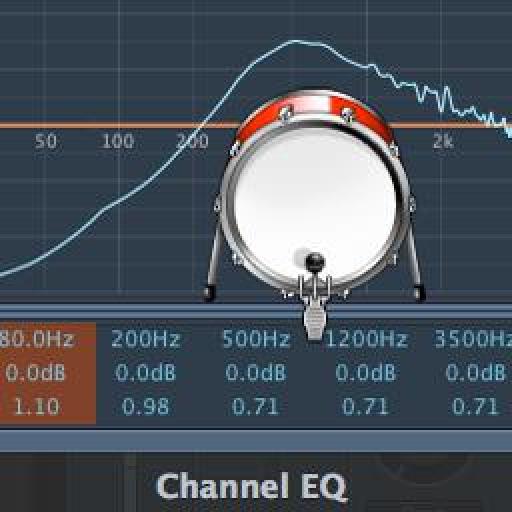Not enough bottom end in your mix? Kick drum a bit weedy, thin or disappointingly lightweight? Using Logic Pro's SubBass plug-in is a well documented method for synthesising very low frequencies where none previously exist, but its use is fraught with the danger of creating multiple clashing frequencies which can cause havoc and potentially wreck a mix with a mess of low end, some of which can't even be heard, unless you have monitors the size of a house. This article shows you how to double the kick drum with a pure sine tone (no harmonics to complicate matters) whose frequency you can control, in both Logic Pro and Pro Tools.
In Logic Pro:
चरण 1: टेस्ट थरथरानवाला
वहाँ दो तर्क प्रो में एक शुद्ध साइन टोन का उपयोग करने के लिए आसान तरीके हैं. पहली EXS24 पारखी के साथ कोई पारखी साधन लोड का उपयोग करने के लिए है, लेकिन इस MIDI नोट खेलने के लिए जानकारी की आवश्यकता है. दूसरा टेस्ट थरथरानवाला, एक काम के लिए अपनी निगरानी प्रणाली और अपने सुनने अंतरिक्ष के ध्वनिक गुण की प्रतिक्रिया का परीक्षण डिजाइन गैजेट है. जब आप एक सॉफ्टवेयर साधन चैनल मैं / हे (उपयोगिता के इनपुट स्लॉट में एक उदाहरण लोड

चरण 2: गेट खोलना
एक शोर गेट टेस्ट थरथरानवाला के रूप में एक ही चैनल पर प्लग में सम्मिलित है, तो ऑडियो ट्रैक किक ड्रम ट्रैक जिसका आप दोगुना करना चाहते हैं अपने पक्ष श्रृंखला इनपुट कनेक्ट. शोर गेट की दहलीज समायोजित इतना है कि यह केवल खुलती है जब किक ड्रम निभाता है.

चरण 3: अपने उप ट्यून
टेस्ट थरथरानवाला एक साइन लहर खेल रहा है की जाँच करें, तो कुछ अपने मिश्रण के लिए उपयुक्त 'subby' (शायद के आसपास 50 से 60 हर्ट्ज) इसकी आवृत्ति कम - लेकिन यकीन है कि तुम सच में सुन सकते हैं, यह क्या कर रहा है के रूप में आप नहीं चाहते एक मिश्रण है कि महंगे स्पीकर सिस्टम को नष्ट कर देगा जारी है!
अधिक सटीक नियंत्रण के लिए, आप नीचे शिफ्ट कुंजी धारण करके आवृत्ति डायल तरह नियंत्रण के आंदोलन को धीमा कर सकते हैं . वैकल्पिक रूप से आप मैन्युअल रूप से आवृत्ति क्षेत्र को डबल - क्लिक करके कोई मान दर्ज कर सकते हैं, एक नंबर टाइप और दबाने वापसी. उप टोन की 'लिफाफा' हमले और शोर गेट पर रिलीज नियंत्रण, लेकिन सावधान रहना का उपयोग कर आकार का हो सकता है, बहुत कम मूल्यों क्लिक पैदा होने की संभावना हैं.
Pro उपकरण
Pro उपकरण में एक या दो मामूली अंतर के साथ बहुत समान दृष्टिकोण है. ज्या लहरों सिग्नल में प्लग में जेनरेटर द्वारा उत्पन्न कर रहे हैं - एक सहायक इनपुट ट्रैक पर पहली सम्मिलित स्लॉट पर क्लिक करें और प्लग - इन के लिए जाना
फिर कुंजी इनपुट के लिए एक अप्रयुक्त बस कनेक्ट. फिर आप किक ड्रम ऑडियो ट्रैक पर भेजें स्लॉट से इस बस के लिए भेज सकते हैं. अंत में शब्द 'साइड चेन के दाएँ हाथ इंटरफ़ेस प्लग में साइड पर सही करने के लिए छोटी सी चाबी आइकन पर क्लिक करके पक्ष श्रृंखला पर बारी. स्वाद, के रूप में के रूप में अच्छी तरह से सिग्नल जेनरेटर की आवृत्ति शोर फाटक के मापदंडों को समायोजित करें.

और वह सब वहाँ यह है!



 © 2024 Ask.Audio
A NonLinear Educating Company
© 2024 Ask.Audio
A NonLinear Educating Company
Discussion
firstly, i set a kick drum on a track strip, standard 4 beat.
i then opened another track strip to open the test oscilator but didnt hear anything? was i meant to open it on the same strip as the kick?
secondly, if im sidechaing the noise gate to the kick drum to i need to convert it to audio first or leave it as midi?
thanks again
drusif
Firstly, the test oscillator should be opened as an instrument in the input slot - it is possible to open it as an insert plug-in but this tip won't work if you do that
For the software instrument kick drum track, these don't appear as available inputs to the sidechain, so you will need to send its output to an aux channel via an available bus. So create an aux channel first, then choose a bus as its input, then connect the output of the kick drum track to that bus. Once you have connected the bus it will be available as a sidechain input to the Noise gate.
Hope that helps.
however im not sure how to open the test oscilator as an instrument? where do i find that option?
tanks
Glad to see it has life in the digital world.
Thanks, Mike!
Want to join the discussion?
Create an account or login to get started!